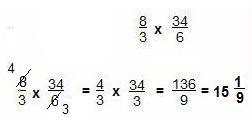
Hint: Change the mixed numbers to improper fractions.
To do this, multiply the denominator times the whole number, and then add the numerator as shown below.
Write the 8 as the numerator and leave the 3 as the denominator to create an improper fraction.
Do the same for the second mixed number.
Multiply as usual.




Some Helpful Tools
Math: Operations with Fractions - Tutorial
This section will cover the fundamentals and rules of adding, subtracting, multiplying, and dividing fractions.
Adding Fractions

Below is a quick review of the parts of a fraction:
Example 2: Fractions with answers that are improper, must be rewritten as a mixed number.
Example 1 : When adding fractions with like denominators, simply add the numerators.

Example 3: Fractions with different denominators will require finding a denominator that both fractions have in common.

Hint: Divide the numerator by the
denominator. Then place the
remainder on top of the divisor to
create a mixed number.
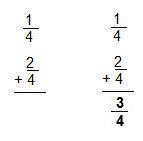



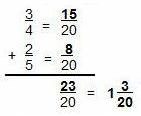

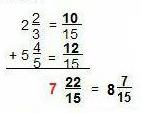
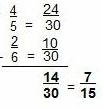


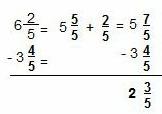
Hint: How many times will 4 go into 20? 5
Multiply 5 x 3. The answer is 15.
The first numerator is 15.
Do the same steps, to find the second numerator.
Example 3: Mixed numbers can be added together.

Step 1:
Step 2:
Step 1:
Step 2:
Step 1:
Step 2:
Step 3:
Step 1:
Step 2:
Step 3:
Step 2 requires finding a common denominator for both 3 and 5. Since 3 cannot go into 5, multiply the two numbers together. The common denominator is 15.
Step 3 requires changing an improper fraction to a mixed number, and then adding the whole numbers together as shown below.
Subtracting Fractions

Example 1 : When subtracting fractions with like denominators, simply subtract the numerators.
Example 2: Fractions with different denominators will require finding a denominator that both fractions have in common. Then subtract the numerators.
Example 3: Subtract a mixed number from a fraction.
Since our answer is not in its lowest term, we will have to reduce. To do this, find the greatest common factor.
Hint: Since we know that our denominator in our mixed number is 5, we will turn our whole number 5 into a mixed number.
To do this, take 1 away from 5, and then turn
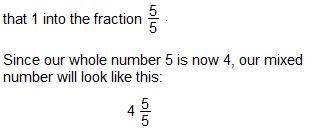
Now we're ready to subtract as usual.
Example 4: Subtract a larger numerator from a smaller numerator.
Hint: Since we can't take 4 from 2, we will borrow 1 from our whole number 6, which we will use to create a mixed number.
Add the mixed number to the original fraction, to make the numerator larger.
Subtact as usual.
Multiplying Fractions
Example 1 : To multiply fractions, follow the steps below:
- Reduce to lowest terms if possible.
- Multiply the numerators.
- Multiply the denominators.
Step 1:
Step 2:
Step 3:
Step 3 shows how to reduce our answer to lowest terms.
To avoid reducing at the end, see if any reducing can be done in Step 1.
For example:

Hint: Since 2 can go into both 2 and 4, we can divide both numbers by 2.
Then multiply as usual.
Example 2 : Multiply the following.
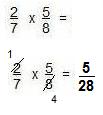
Example 3 : Multiply two fractions and reduce diagonally both ways.
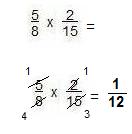
Note: Reducing a fraction to lowest terms when multiplying can only be done diagonally.
Example 4 : Multiply multiple fractions
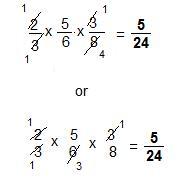
Note: Whichever way we reduce, the answer is the same.
Example 5 : Multiply mixed numbers.
Step 1:
Step 2:

Dividing Fractions
Example 1 : Divide fractions:
- Change the division sign to a mutliplication sign. (Step 2)
- Write the reciprocal of the second fraction. (Step 2)
- Reduce fractions to lowest terms. (Step 3)
- Multiply as usual. (Step 3)
Step 1:
Step 2:
Step 3:
Example 2 : Divide mixed numbers:
- Change the mixed numbers to improper fractions. (Step 2)
- Write the reciprocal of the second fraction. (Step 3)
- Reduce fractions to lowest terms if possible.
- Multiply as usual. (Step 4)
Step 1:
Step 2:
Step 3:
Step 4:
Example 3 : Divide a mixed number by a whole number:
- Change the mixed number to improper fractions. (Step 2)
- Change the whole number to an improper fraction. (Step 2)
- Write the reciprocal of the second fraction. (Step 3)
- Reduce fractions to lowest terms if possible.
- Multiply as usual. (Step 3)

Step 1:
Step 2:
Step 3:
1st mixed number
2nd mixed number
